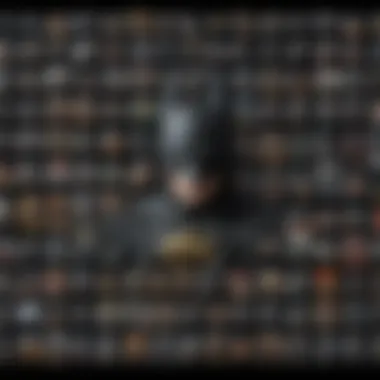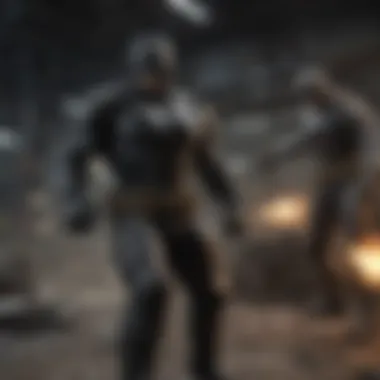Exploring the Legacy of Batman Video Games


Intro
In the realm of video games, few characters have captured the imaginations of players quite like Batman. The Dark Knight—an embodiment of justice and complexity—has undergone numerous iterations since his first appearance on screen. As gaming technology has evolved, so too have the narratives and mechanics surrounding this iconic figure. From pixelated adventures to stunning 3D landscapes, the Batman video game franchise has left an indelible mark on the gaming industry.
In exploring this rich tapestry, we’ll navigate the key phases of Batman's gaming journey. We’ll delve into gameplay mechanics that keep players on the edge of their seats, analyze storylines that evoke emotional responses, and reflect on the cultural impact that this hero continues to have. Whether you're a long-time fan or newer to the gaming scene, understanding this evolution is essential to appreciating what Batman represents in video games today.
Overview of the Game
Game Title
One standout title in the Batman video game collection is Batman: Arkham Asylum. Released in 2009, it marked a significant turning point for superhero games, setting a high bar for narrative-driven gameplay.
Release Date
Batman: Arkham Asylum made its debut on August 25, 2009.
Developer
Developed by Rocksteady Studios, this game introduced players to a dark, immersive version of Gotham City, beautifully crafted to echo the comic book's tone.
Genre
Primarily categorized as an action-adventure game, it combines elements of stealth, combat, and exploration, offering a multifaceted gaming experience.
Gameplay Review
Graphics Quality
The graphics in Arkham Asylum are visually striking. The character designs are detailed, and the atmosphere resonates with the eerie silence of a mental institution gone awry, imbuing realism in a fictional setting.
Controls
Designed intuitively, the controls enable fluid movement through the game world. Players can easily switch between stealth modes and combat, ensuring that gameplay remains dynamic and engaging.
Mechanics
Combat mechanics include a unique Freeflow system allowing smooth transitions between attacks, dodges, and counters. This adds a layer of strategy; timing and positioning are crucial.
In-Game Features
The game’s detective mode provides players with a unique perspective, revealing hidden objects and lifeforms around them. This feature complements Batman's persona, as it reflects his analytical mind.
Storyline Analysis
Plot Summary
Batman: Arkham Asylum opens with Batman apprehending the Joker. But chaos ensues when the Joker takes control of Arkham, forcing Batman into a night of battles against notorious villains.
Characters
The game introduces a vibrant cast including Harley Quinn, Scarecrow, and Bane. Each character plays a vital role in creating tension and depth within the plot.
Pacing
The pacing is meticulously crafted. Each encounter unfolds naturally, with the narrative development seamlessly guiding players through intense moments that keep them invested in the storyline.
Narrative Depth
Themes of fear, madness, and morality weave through the plot, elevating it beyond typical superhero fare. The emotional undertones linger long after the credits roll.
Community Impact
Popularity Trends
Since its release, Batman: Arkham Asylum has seen continuous popularity, inspiring loyal fandoms across various gaming platforms. Its critical and commercial success has led to multiple sequels and spin-offs.
Updates and Patches
Rocksteady Studios has shown dedication to maintaining quality through updates, ensuring a smooth experience for gamers and addressing any issues that pop up post-release.
Competitive Scene
While not primarily a competitive game, the Arkham series has sparked interest in speed-running communities. Players often share tips and strategies on platforms like reddit, creating a supportive environment for both new and seasoned gamers.
"Batman: Arkham Asylum transformed the superhero gaming genre, reminding us that even a larger-than-life character can have a grounding, human narrative."


As we continue to untangle the rich history of Batman video games, each chapter offers insights not only into gameplay but also into cultural reflections that resonate with fans worldwide.
Historical Context of Batman Video Games
Understanding the historical context of Batman video games offers crucial insights into their development and cultural significance within the gaming landscape. Exploring this history allows us to appreciate how the franchise has evolved alongside the gaming industry itself, reflecting changes in technology, storytelling, and audience engagement. Notably, the journey of Batman in this medium not only mirrors the evolution of gaming but also highlights societal perceptions of the iconic character over the decades.
Origins in the Gaming Industry
Batman video games found their early footing in an industry rapidly maturing post the arcade boom of the late 1970s and early 1980s. The first game to feature the Dark Knight was Batman released in 1986 for the Commodore 64. Though simplistic by today’s standards, it showcased a hero who needed to fight crime, paving the way for more sophisticated adaptations. The charm of the pixelated graphics and basic mechanics catered to a niche audience, but it was enough to spark interest in portraying the superhero in interactive formats.
The early 1990s marked a significant turning point as the release of Batman: The Video Game for the Nintendo Entertainment System took inspiration from Tim Burton's film, blending action with compelling narrative elements. This game demonstrated how Batman could adapt to the video gaming environment, marrying fierce gameplay with the cinematic appeal of the character. Not only did it reflect the aesthetics of the film, but it also introduced gaming fans to a dynamic Batman who could jump, punch, and battle villains in a tight storyline.
As gaming technology advanced, so did the complexity and depth of Batman titles. The mid-90s witnessed the arrival of Batman Forever and Batman & Robin, both of which further developed gameplay mechanics and narratives, albeit with varying degrees of success. Both media and gaming were still learning to blend storytelling and gameplay, setting the stage for future endeavors to create immersive experiences.
Key Milestones and Developments
The journey toward creating memorable Batman video games is punctuated by several key milestones that have shaped the very fabric of the franchise.
- 1999’s Batman: The Animated Series game for PlayStation was a notable leap, capturing the essence of the beloved show and introducing a more cinematic approach to narrative-driven gameplay.
- Following that, the release of Batman Begins in 2005 not only served as a tie-in to the film but pushed the boundaries of how licensed games could capture the essence of their source material.
- However, the transformation reached new heights with Batman: Arkham Asylum in 2009, which is often hailed as a turnaround for superhero games. Developed by Rocksteady Studios, it emphasized stealth, combat, and a robust storyline, establishing a benchmark for future developments across various platforms.
"The arrival of Arkham Asylum has often been seen as the moment superhero games finally found their footing, blending a rich narrative with gameplay that captured the essence of the characters involved."
The success of the Arkham series sparked a renewed interest in not only Batman but also superhero gaming as a whole. It set a template for integrating narrative depth with player choice that many games would follow thereafter. In a world where video game storytelling is becoming increasingly sophisticated, the legacy of early Batman games cannot be underestimated. From their humble beginnings to the complex titles of today, they have played a pivotal role in shaping gaming culture and influencing how heroes are portrayed in interactive media.
The Evolution of Gameplay Mechanics
The evolution of gameplay mechanics in Batman video games reflects the broader trends and innovations in the gaming industry. This section explores how gameplay has not only changed but has also defined player experiences, setting the tone for what fans expect from superhero titles. From rudimentary designs to intricate systems involving stealth, combat, and exploration, the journey of Batman video game mechanics is as riveting as the Dark Knight's own narrative.
Early Gameplay Styles and Mechanics
In the earlier days of Batman gaming, the mechanics were, to put it mildly, rather simple. Titles like Batman: The Video Game, released on the NES in 1990, featured side-scrolling action with basic combat mechanics. Players often felt like they were just button-mashing their way through waves of enemies, as game design hadn’t yet matured.
Initially, players engaged in platforming challenges that leaned heavily on trial and error. Limited interactivity was commonplace, and the graphics reflected the technological constraints of that era—blocky characters and pixelated enemies dominated the visual landscape. However, these early days set the groundwork for more complex systems to emerge. As developers learned from feedback, new gameplay styles began to take shape.
Some important elements that characterized these early titles included:
- Limited Movement Options: Batman’s agility was often reduced to jumping and punch-kicking foes.
- Static Levels: Environments were more about reachability than immersion. Each level had a start and finish, with very little exploration required.
- Basic AI: Enemy behavior was predictable, providing little challenge beyond mere numbers.
Although rudimentary, this era laid the foundation for future titles to build upon. It falsely suggested that the character’s intelligence, much like that of the enemies in the game, was limited. As gaming technology advanced, developers began infusing more narrative and depth into the mechanics.
Advancements in Graphics and Controls
As technology improved through the late 1990s and into the 2000s, Batman video games began to mirror significant developments in other gaming genres. With the introduction of titles like Batman: Arkham Asylum, developers aligned graphics with gameplay mechanics, creating a symbiotic relationship that enhanced the overall player experience.
- Rich Environments: The introduction of 3D graphics allowed for richly detailed environments. Gotham City became a living, breathing metropolis, full of secrets, nooks, and crannies. Players found themselves immersing in a world that had texture and depth.
- Fluid Controls: Advances in control schemes allowed for complex move sets. Players could now easily fluidly transition between stealth tactics and all-out brawls. This shift not only made the gameplay more engaging but also encouraged strategic thinking.
- Enhanced AI: Improved enemy AI meant that players faced more realism in combat situations. Foes adapted, strategized, and sometimes even worked together against the player. The tactical depth added layers of complexity previously absent in simpler titles.
A quote that captures this shift might be:
"The evolution of gameplay mechanics is not just about technology; it's about creating the very essence of what it means to be Batman—thinking like a detective, fighting like a hero, and navigating a world fraught with peril."
By combining stunning visuals with intuitive controls, the evolution of gameplay mechanics in Batman video games revolutionized not only how players perceived the Dark Knight but also how developers approached the superhero genre's narrative storytelling capacity. Engaging players in multifaceted ways has allowed them to feel a deeper connection to Batman's struggles and triumphs, making these games some of the most celebrated in the industry.
As we look to the future, the trajectory of gameplay mechanics in Batman games serves as a testament to the marriage of innovation and creativity in interactive entertainment.
Major Titles in the Batman Franchise
The Batman video game franchise has seen numerous titles that have each left an indelible mark on gaming culture. These major titles are not only pivotal in providing entertainment but also play a substantial role in shaping the identity of Batman as a gaming character. They offer insights into the evolving gameplay mechanics, narrative styles, and technological advances that have defined the series over time. The Arkham series stands out particularly, fundamentally redefining gaming standards with its combination of gameplay innovations and deep storytelling.
Each title contributes significantly to constructing the legacy of Batman in interactive entertainment. By studying these games, one can appreciate how Batman's character has been portrayed in various lights throughout the years—from a brooding vigilante to a complex hero facing moral dilemmas.
Arkham Series: Redefining the Genre
Gameplay Innovations
When discussing Gameplay Innovations within the Arkham series, one cannot ignore how the free-flow combat system reinvented how players engage in combat. The system allows for fluid, continuous action that makes players feel like they are truly embodying the Dark Knight. Rather than relying solely on button-mashing, the combat incorporates evasion, counters, and gadgets, enhancing strategic depth.
These innovations benefit the overall experience, offering both novices and seasoned players the chance to experience dynamic battles while maintaining a sense of control. A unique feature of this combat is the environmental interactions, where Batman can use the surroundings to his advantage. Whether it’s looking for a gargoyle to swoop in on an enemy or using the environment to disarm thugs, this keeps the gameplay fresh.
However, one could argue that this freedom can sometimes overshadow the narrative, leading to moments where players might prioritize action over story progression. Nonetheless, the innovations introduced here have become a standard in action-adventure games and set a high bar for future titles.
Narrative Complexity
The narrative complexity is another noteworthy aspect of the Arkham series. What sets it apart is its ability to delve into the psychological and emotional depths of characters. The storylines are more than just questing to defeat villains; they explore themes of identity and morality. The character development is profound, allowing players to see Batman’s internal struggles.
This characteristic proves beneficial because it adds layers to the gameplay experience. A unique feature is the use of telescoped narratives, where players can piece together the story through environmental storytelling and character interactions, enhancing immersion. However, the complexity might intimidate some players who prefer straightforward narratives, which could limit accessibility.


Non-Arkham Titles: An Overview
Analysis of Spin-off Games
When analyzing the spin-off games, it's essential to highlight how they often stray from the established formulas of the Arkham series, offering fresh perspectives on Batman’s universe. For instance, titles like Batman: The Brave and the Bold focus on cooperative gameplay, shifting the focus from Batman's solitary nature to teamwork. This shift offers players a unique experience, although it might not resonate with every fan.
Such games also allow for more experimental mechanics that wouldn't fit in the darker atmosphere of the Arkham series. However, these innovations can be a double-edged sword; while they provide variety, they can also lead to inconsistency in tone and gameplay experience compared to the somber narratives typically expected in Batman games.
Comparison to Arkham Series
Finally, comparing non-Arkham titles to the Arkham series highlights the diversity within Batman's gaming landscape. Titles like Batman: Vengeance or even Lego Batman offer varied gameplay mechanics and tones. While the Arkham series embraces a darker palette and intense storytelling, the others might veer into lighter territory or focus on different gameplay styles, such as puzzle-solving or platforming.
The key takeaway from this comparison is that while the Arkham series sets a high standard, the non-Arkham titles add to the richness of the franchise, catering to diverse audiences and preferences. The trade-off here is noticeable—the accessibility of non-Arkham titles may attract a broader audience, but they often lack the depth and engagement found in Arkham's narrative-heavy plots.
Narrative and Thematic Depth
The interplay between narrative and thematic depth in Batman video games serves as a powerful tool in shaping both the player's experience and understanding of the iconic character. It's not just about battling villains and completing missions; it's about delving into the psychological intricacies of Batman and the moral dilemmas he faces. This duality enhances gameplay, making it more engaging and thought-provoking than typical action-adventure offerings.
In much of the Batman franchise, narrative threads are woven intricately, highlighting key questions around identity and morality while examining the very nature of heroism. This means that players aren’t merely participants; they are invited to reflect on the choices presented within the game world. Each decision can lead to varied outcomes, allowing players to explore different facets of Batman's character.
Exploration of Batman's Mythos
Identity and Morality
At the heart of Batman's narrative lies a profound exploration of identity and morality. Players are often confronted with choices that compel them to contemplate Batman's moral code. For instance, options to save a character or apprehend a villain can force players to grapple with the consequences of their actions. The character of Batman embodies a continuous struggle between good and evil, making players reflect on their own moral compass.
The key characteristic here is Batman's commitment to uphold justice without crossing into dark territory, which makes it a compelling choice for storytelling. It's beneficial because it allows for narrative complexity, delving into themes like redemption and sacrifice. Players find themselves weighing the costs of each choice against their allegiance to the Batman persona. While these aspects provide depth, there are potential downsides. Sometimes, the weight of morality can slow down gameplay, leading to moments of introspection that might not be appreciated by every player.
Brolling Villains
Another crucial aspect of Batman's narrative is the brolling villains who populate his universe. Each adversary, from the Joker to the Riddler, represents not just a physical threat but also poses profound psychological and philosophical questions. The creators have made these characters richly layered, often reflecting Batmans' own internal battles.
The inclusion of such diverse and complicated villains is a staple of what makes these games stand out. This thematic depth not only draws players deeper into the storytelling but also enhances their connection to Batman. It empowers players to understand that each villain is not just a foe, but also a mirror reflecting the possible paths Batman could take if he were to stray from his moral path. However, keeping these characters consistent can be challenging. New interpretations can sometimes lead to mixed reactions from fans who have their own expectations rooted in comic lore.
Player Choices and Their Consequences
As players engage with Batman’s story, the concept of choice becomes pivotal. Decisions fundamentally shape not just the immediate gameplay experience but also the overarching narrative arcs. There’s an underlying message: choices have consequences, a principle that resonates with the central tenets of Batman's journey as a character.
In various scenarios, players can either adhere to Batman's code or take shortcuts that may seem expedient but compromise their integrity. Each choice can lead to different endings, or change the dynamics of player relationships, illustrating the ripple effect of decision-making within the game world. This dynamic engagement with player choice continually invites reflection, ensuring that the gaming experience extends well beyond the screen and promotes a dialogue about ethics, identity, and morality.
By embedding such depth within gameplay, Batmans' video games not only entertain but also challenge players to confront their own ethical standpoints, making these titles both immersive and intellectually stimulating.
The Role of Graphics and Art Direction
Graphics and art direction play a pivotal role in shaping how a video game is perceived and experienced. For Batman video games, these elements are not just cosmetic features; they serve as essential storytelling mechanisms that enrich the player's immersion in Gotham City. The visual design creates a backdrop for character interactions while invoking the moody allure of the comic book lore. As players navigate through dark alleys, sleek rooftops, and sinister villain lairs, the graphics breathe life into the narrative.
This resonance between art direction and gameplay helps define the emotional tone of each title, ensuring that players feel the weight of their choices and actions. Hence, it's crucial to understand not just the aesthetic choices made, but also the deeper implications of these visuals.
Artistic Inspirations and Styles
Comic Book Aesthetics
Comic book aesthetics have significantly influenced the visual direction of Batman video games. The bold lines, vivid colors, and exaggerated expressions are hallmark traits that evoke the essence of illustrated narratives. This choice is beneficial as it establishes an immediate connection with those familiar with the source material.
A key characteristic of comic book aesthetics is how they encapsulate the hyper-realism of the characters and environments. Characters like Batman, with their iconic silhouettes and detailed costumes, come alive against the vibrant backgrounds echoing Gotham’s gritty atmosphere.
The unique feature of this style is its ability to portray action and drama dynamically, making every encounter feel like a scene out of a graphic novel. However, one could argue that the reliance on comic book visuals could run the risk of distancing some players who might prefer more realistic graphics. Yet, for many fans, this stylized look is an advantage, creating a nostalgic experience that ties back to the comics they cherish.
Film Influences
Film influences also play a major role in shaping the graphics in Batman games. The cinematic style is not just about realism; it conveys moods and themes often seen in popular Batman films. Think of the shadowy lighting akin to Christopher Nolan's trilogy, or the almost whimsical yet dark aesthetics reminiscent of Tim Burton’s take on the Dark Knight. This choice is popular because it resonates with film enthusiasts, bridging the gap between different media.
One unique aspect of film influences is the dynamic camera work that enriches gameplay. Players often feel like they are part of a film, living the story as it unfolds around them. This approach adds immersion and elevates the gaming experience. However, an overemphasis on cinematic visuals might sometimes lead to a gameplay experience that feels more like watching a movie than engaging in meaningful interactions. But when executed well, the merging of film and gameplay leads to a captivating experience that few can resist.
Technical Developments Over Time
The advancements in technology have significantly influenced the graphics and art direction of Batman video games, reshaping how players engage with this beloved franchise. Initially, the character designs featured pixelated graphics, which, while charming, lacked the finesse we see today. Fast forward to the latest innovations, and the evolution of visual fidelity is evident.
Textures have become more sophisticated, environments are intricately detailed, and the characters' expressions are nuanced enough to convey emotion. This progression unlocks new dimensions of storytelling as visual cues now play a crucial role in expressing narrative depth. With cutting-edge graphics engines, developers can create massive open worlds that feel alive, enhancing exploration and interaction.
In this ever-evolving landscape, integrating new technologies–such as ray tracing for lighting effects or AI-driven animations–further enriches the gameplay. As these technical advancements continue to unfold, the artistic direction will evolve to maintain its relevance and impact, ensuring that Batman video games remain a staple in gaming culture.
In the end, the graphics and art direction in Batman video games are not merely aesthetic choices, but rather essential tools that inform players about the universe they are entering, providing layers of meaning that enhance the overall experience.
By melding artistry with interactivity, these games deliver a comprehensive narrative that resonates deeply with audiences while pushing the boundaries of what is visually achievable.


The Impact of Batman Video Games on Gaming Culture
The influence of Batman video games extends far beyond mere entertainment; they have fundamentally shaped gaming culture in ways that resonate with fans and developers alike. This segment seeks to illuminate the direct and indirect contributions these titles have made to the larger gaming ecosystem.
Ultimately, Batman’s leap from comic book pages to the gaming console sparked an entire subgenre of action-adventure titles, engaging both new players and seasoned gamers. Here, we will explore how these games have redefined norms and influenced next-generation titles.
Contribution to Genre-Defining Standards
Batman video games set the bar high, particularly with the Arkham series. The meticulous attention to detail in both gameplay and storytelling created a template that many game developers followed. The Arkham series pioneered an open-world design that seamlessly integrated combat, exploration, and narrative.
Some of the key features that became standards include:
- Fluid Combat Systems: The combat mechanics, particularly in Batman: Arkham Asylum, introduced a combo-driven approach that was both satisfying and visually engaging.
- Narrative Richness: Complex stories interwoven with character development allow players to connect with the narrative on a deeper level.
- Immersive Environments: A Gotham City that feels alive, packed with easter eggs, quests, and challenges.
These contributions have been foundational, as other games, like Spider-Man by Insomniac Games, have borrowed heavily from this structure, indicating success is often about learning from the best.
Crossover into Pop Culture
While Batman has always been a cultural icon, the video games have helped propel him into even broader recognition across various media.
Community Engagement
One aspect of community engagement that stands out is how the games have fostered discussions across platforms like Reddit and Facebook. Fans often dissect mechanics, narrative interpretations, and underlying themes online, creating a vibrant community space.
- Key Characteristic: Interactive Fan Communities
The ability for players to share experiences and strategies brings a unique dimension to their gaming experience. It’s not just about playing; it's about sharing—making this an essential facet of console gaming. - Unique Feature: Global Events
Special events, like fan art competitions or community challenges, have attracted gamers and creators alike. This fosters a sense of belonging and collaborative spirit, enriching the overall experience. - Advantages and Disadvantages:
While community engagement can enhance the gaming experience, sometimes it circles into toxic behavior, which could dissuade new players from participating. Nevertheless, the benefits generally outweigh the negatives, making this an integral part of Batman’s gaming legacy.
Merchandising and Collaborations
Merchandising, particularly around video games, has become a significant revenue source, extending the brand’s reach. Partnerships with companies for exclusive in-game items or physical merchandise keeps the franchise in players’ minds long after they have finished a game.
- Key Characteristic: Brand Collaborations
Collaborations with brands, from apparel to collectibles, show how versatile the Batman brand is. Companies frequently leap at the chance to partner with a franchise of such notoriety to attract audience attention. - Unique Feature: Limited-Edition Releases
Special packaging or versions, such as the Arkham Knight: Limited Edition, amplify excitement in the community, attracting not only gamers but collectors too. - Advantages and Disadvantages:
This expansion can lead to brand dilution if not handled well, but the financial backing can bolster future game developments, proving beneficial overall.
"Batman transcends mere representation in comics and games; it has evolved into a cultural phenomenon that fosters exchanges among diverse audiences across multiple platforms."
As we explore the cultural impact of Batman video games, it becomes clear that their significance transcends gameplay, influencing community dynamics and merchandising approaches alike. The evolution within this space speaks to a broader significance within the gaming industry.
The Future of Batman in Video Games
When we consider the forthcoming landscape of Batman video games, we delve not only into the anticipated titles but also into the transformative potential these games have. The importance of this section lies in the exploration of how future developments could redefine gameplay and storytelling techniques. With advancements in technology and the ever-evolving preferences of gamers, understanding what lies ahead is crucial for enthusiasts and stakeholders alike.
Anticipated Releases and Developments
Several anticipated releases of future Batman titles have stirred excitement among fans. One such title is Gotham Knights, which has captured imaginations for its promise of an open-world environment set in the rich Gotham universe. This game is expected to shift the focus toward characters like Batgirl and Nightwing, instead of solely on Batman, reflecting a growing trend of expanding narratives.
The potential for a new Arkham installment raises questions as well. Having set a gold standard, any continuation in this series would aim to innovate further on what was achieved previously. As Batman Begins did for the films, these upcoming games have the potential to deepen the mythology, offering new gameplay mechanics, immersive worlds, and innovative storytelling.
Additionally, there's buzz around possible crossovers with other franchises or even the chance for Batman to step into genres not typically associated with the Caped Crusader. This could facilitate novel approaches, allowing for fresh interpretations of the Batman character and his allies.
Adapting to Emerging Technologies
Virtual Reality Prospects
Virtual reality is shaking up gaming in ways previously unimaginable. When we talk about the Virtual Reality Prospects in Batman games, we refer to creating a more immersive experience that lets players step directly into Batman's cape. This is not just about a new way to play; it's about experiencing Gotham as if one were walking its streets and engaging in stealth missions firsthand.
The significant characteristic of VR is its ability to engage players' senses fully, and that makes it an appealing direction for Batman games. The thrill of peering around corners or the adrenaline rush of gliding through the city can be translated into the virtual world, leading to a completely unique gaming experience.
However, the inclusion of this technology presents its own challenges. Not everyone has access to VR gear, and the development process can be resource-intensive. But its potential to redefine how players interact with beloved characters is too enticing to ignore.
Mobile Gaming Innovations
Mobile gaming has taken massive strides in recent years. The realm of Mobile Gaming Innovations is particularly promising for the Batman franchise. With the increasing power of mobile devices, we see an opportunity for games that are not only accessible but also rich in gameplay.
The ability of mobile platforms to reach a broader audience makes it a beneficial choice for reaching new fans who might not own gaming consoles. This could mean more story-driven experiences that fit into the palm of your hand, allowing players to take Gotham with them on the go.
A unique feature of mobile gaming is the potential for interactive narratives that utilize the device's capabilities. This could make for engaging storytelling through augmented reality or apps that let players solve crimes like the Dark Knight himself. Yet, this shift also has disadvantages. Mobile platforms may struggle to deliver the same graphical quality and depth of gameplay found in traditional gaming, thus challenging developers to balance quality and accessibility effectively.
"The forthcoming Batman games will likely usher in a new era of immersive storytelling and innovative gameplay, merging familiar character narratives with fresh technology to engage players like never before."
As we navigate this promising horizon, it’s clear that whether through VR or mobile platforms, the future of Batman in video games is bright. Enthusiasts can look forward to transformative experiences that not only pay homage to the past but also challenge the very fabric of what makes a Batman game special.
Finale: The Legacy of Batman Video Games
The legacy of Batman video games is as multifaceted as the Dark Knight himself. Over the years, this franchise has not only provided a rich interactive platform for players but also paved the way for significant shifts in the gaming industry. Looking back, it’s apparent that Batman games have played a key role in shaping narrative and gameplay standards across numerous genres, leaving an indelible mark on both players and developers alike.
First off, the innovation in gameplay mechanics cannot be understated. From the simplistic platformers of the early 90s to the complex, multi-faceted experiences offered by the Arkham series, each entry has pushed boundaries. Players now expect not just action, but nuanced storytelling alongside immersive environments. Titles like Batman: Arkham Asylum introduced players to the concept of combining combat with detective work, setting a new standard that would influence countless future games, not only in the superhero genre but across all gaming platforms.
Moreover, Batman's character has become a canvas for exploring deeper themes such as justice, morality, and the psychological struggles of both heroes and villains. This is seen vividly in games that allow players to navigate difficult choices, reflecting real-life ethical dilemmas. It engages players on an emotional level, making them ponder their own values and the consequences of their decisions.
"The transformation of Batman games has transcended mere entertainment, evolving into a medium that explores the human experience."
As the gaming landscape continues to morph with advancements in technology, Batman's legacy remains as relevant as ever. The potential for future innovations, such as virtual reality and enhanced AI, opens up exciting possibilities. Gamers are now not only looking for engaging stories; they yearn for a connection to the characters that resonate with their real-life experiences. The expectation of experiencing Gotham in even more personalized ways keeps the legacy alive and thriving.
Additionally, the influence of Batman video games on pop culture is unmistakable. From merchandise to cinematic adaptations, Batman games have helped solidify the franchise's place within the broader entertainment industry. The ability of these games to create fandom communities on platforms like Reddit or Facebook showcases how interactive narratives can cultivate a strong sense of belonging among players.



